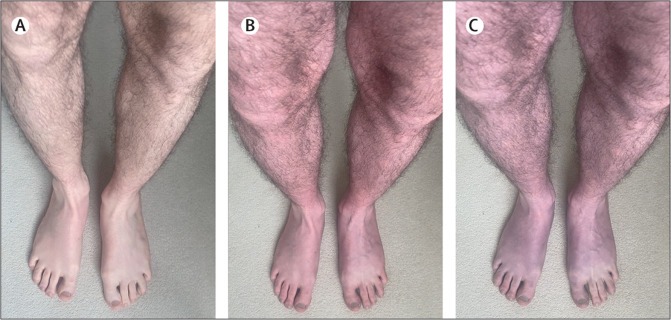Published on
Updated
Reading 2 mins.
in collaboration with
Eric Caumes (Infectiologist)
Doctors have just described a new symptom, which could be consecutive to the long Covid. A patient sees his legs change color when he gets up. The point of view on the question of Eric Caumes, infectiologist and consultant at the Hôtel-Dieu, in Paris.
Legs that turn purple when he gets up. This is what is happening to a 33-year-old man who suffered from Covid long after contracting the infection a year and a half ago. This rare case was described by doctors from the University of Leeds in the United Kingdom and whose study was published in the Lancet.
Legs that blush, then turn purple
This unusual symptom would have been felt by the young man for six months. Every time he stands up, he feels a heaviness in his legs, then a kind of irritation and tingling all along them.

Gradually turning red, after one minute, his legs would then gradually turn purple-blue, over the next ten minutes. The man then presents with a kind of rash on his feet. Everything would then return to normal when he sits down or lies down.
Measurements taken while standing and lying down
The doctors who took an interest in his case carried out a series of measurements including his blood pressure and his pulse in the supine position and in the standing position, after 8 minutes.
results: His pulse was found to be abnormally high at 127 beats per minute. In addition to this tachycardia, the man described feeling a feeling of mental fog and tremors, which doctors consider postural orthostatic tachycardia syndrome.
A case of acrocyanosis revealed after Covid-19 infection
“This was a striking case of acrocyanosis in a patient who had not experienced it prior to his Covid-19 infection” explains one of the study’s authors, Dr. Manoj Sivan.“Patients who experience this may not be aware that it may be a symptom of long Covid and may be concerned about what they are seeing.”
Asked about this particular case, Professor Eric Caumes, specialist in long Covid cases, believes that it is difficult to make this case a generality.
“I would rather speak of a sequel to the Covid-19 infection rather than a symptom of the long Covid. Moreover, this young man is a unique case: is it a real sequel or simply a “coincidence”? Was this acrocyanosis to occur and develop in this patient, in any case?… Nevertheless, we can currently say that the Covid does indeed seem to have a vascular tropism: we have been able to notice that it causes for example, vasculitis. So this particular case is not really surprising.”
